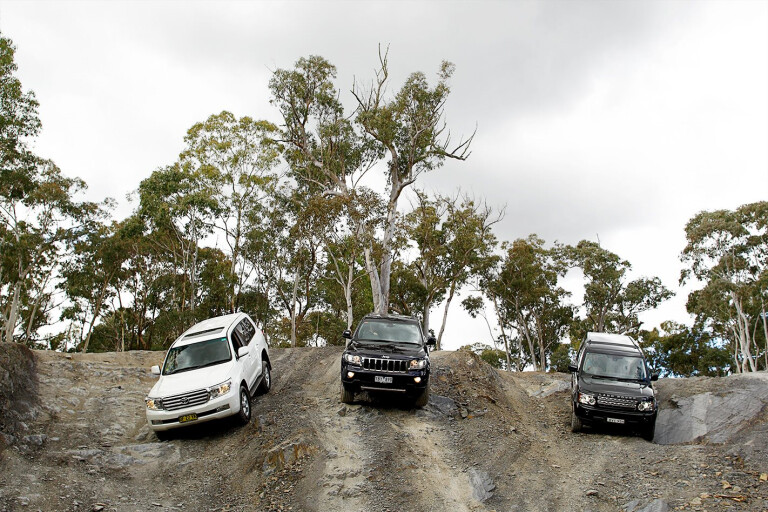
IN these troubled times of high fuel prices and efficient turbo-diesel engines, you might wonder why anyone would consider buying a petrol-powered V8 4X4 wagon.
This article was first published in 4x4 Australia's October 2011 issue.
The plain facts are that diesel is the cheaper long-term option for most vehicles, and the torque of a diesel engine offers more relaxed driving at the expense of a little extra engine noise and vibration. But not all engine noise is bad – there’s nothing like the note of a bellowing V8.
More importantly, large-capacity V8s have long been considered powerhouse performers, thanks to their high levels of torque and effortless acceleration. It’s some accolade for smaller diesel donks to be said to have ‘V8-like’ torque. And it’s this grunt that makes the V8 such a sweet performer in heavy 4X4 wagons – but it comes at a cost when you reach for the petrol pump.
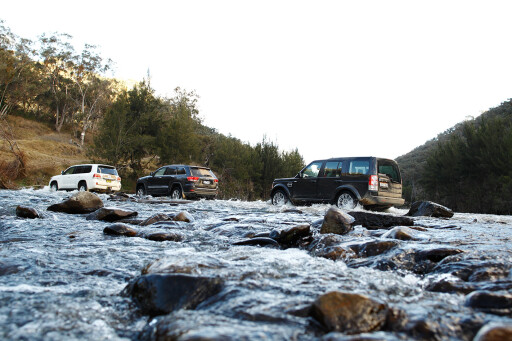 So what’s the bottom line? Is a V8 worth the extra freight? Let’s check out three of the best… Our trio of thundering V8s starts with the relatively new Jeep Grand Cherokee. The 5.7-litre Hemi V8 in the base model of the GC WK Limited line-up makes it great value at $60,000.
So what’s the bottom line? Is a V8 worth the extra freight? Let’s check out three of the best… Our trio of thundering V8s starts with the relatively new Jeep Grand Cherokee. The 5.7-litre Hemi V8 in the base model of the GC WK Limited line-up makes it great value at $60,000.
Our test vehicle comes fully loaded with all the available option packs, including the Off-Road Adventure Group at $1950, which gives you the Quadra-Drive II 4X4 system, underbody skid plates and 18-inch alloy wheels; then there’s Quadra-Lift adjustable air suspension at $3250; the Luxury Group incorporating U-Connect media system with satnav, a power-operated tailgate and heated steering wheel for a further $3250; Premium Paint at $495 and a Panoramic Sunroof at $3250.
Add it all up and at $72,462 the GC is jam-packed with features, giving excellent bang for your buck. Toyota’s LandCruiser 200 Series V8 costs $106,164 and comes with everything in the LC200 option list, except for the diesel V8 engine. Land Rover’s Discovery 4 V8 starts at $127,500 and you can only add metallic paint, which costs an additional $1800.
Land Rover’s D4 V8 gets the full complement of Discovery features and offers higher spec than even the TDV6 HSE. Compare those prices, and you’d conclude that no-one looking at a Discovery 4 V8 would consider buying a Grand Cherokee – unless he or she is looking for a two-for-one deal!
 The Jeep also falls out of consideration if seating is critical, as it offers two rows for five passengers, where the LC200 and D4 each have three rows totalling eight and seven seats respectively. And, after all these years, the Discovery’s rear seats are still the best in the business: they are easy to operate, fold flat into the floor when not needed, and accommodate real-sized people.
The Jeep also falls out of consideration if seating is critical, as it offers two rows for five passengers, where the LC200 and D4 each have three rows totalling eight and seven seats respectively. And, after all these years, the Discovery’s rear seats are still the best in the business: they are easy to operate, fold flat into the floor when not needed, and accommodate real-sized people.
On the other hand, the LC200’s rear seats fold up to the side, so they are always in the way, and when in use have a high floor so their occupants have their knees up around their heads. None of our three wagons falls short on interior features – not even the Jeep at half the price of the other two.
Even without the Luxury Group option, the Grand Cherokee Limited gets the touch-screen media unit with 30GB hard drive, Bluetooth phone and audio, and rear-view camera; the Luxury Group adds satnav to the unit.
There’s dual-zone climate control, leather trim, heated and powered adjustable front seats, cruise control, keyless entry and starting, a tyre pressure monitoring system with dash display, bi-Xenon HID headlights, and automatic wipers.
 The Limited’s wheels are 20-inch alloys as standard, but with the Off-Road Adventure Group, these are swapped for more practical 18s wearing 265/60 rubber. We expect the 18s would offer a more comfortable ride than the 20s, as the Grand already has very firm suspension.
The Limited’s wheels are 20-inch alloys as standard, but with the Off-Road Adventure Group, these are swapped for more practical 18s wearing 265/60 rubber. We expect the 18s would offer a more comfortable ride than the 20s, as the Grand already has very firm suspension.
The Limited’s safety gear includes ABS brakes, traction and stability control, and seven airbags. Jeep’s new Selec-Terrain traction-control system comes standard, with settings for Sport driving, Snow, Sand and Mud.
There’s also an Auto setting. It’s not as refined or sophisticated as the Land Rover Terrain Response system it mimics, and gives some strange dash messages when in use, but it does most of what is required of it when set to Auto.
Selec-Terrain works with the Quadra-Drive II 4X4 system, which is a full-time four-wheel-drive with an auto-locking centre differential. QD-II comes with the Off-Road Adventure Group and adds an auto-locking rear diff to the package.
 As it stands, the new Grand Cherokee struggles on loose, slippery climbs as the tyres scrabble for grip from what seem to be slow-acting electronics. It’s not helped by the independent height-adjustable air suspension, which uses short control arms that restrict wheel travel and allow the tyres to lose contact with the track – thus requiring more intervention from the electronics.
As it stands, the new Grand Cherokee struggles on loose, slippery climbs as the tyres scrabble for grip from what seem to be slow-acting electronics. It’s not helped by the independent height-adjustable air suspension, which uses short control arms that restrict wheel travel and allow the tyres to lose contact with the track – thus requiring more intervention from the electronics.
Where the Jeep’s off-road electronics do work well is in hill-descent control (HDC) which, as described in our August issue’s V6 wagon comparo, operates more effectively and smoothly than any comparable system offered today. It’s worth noting here that HDC, like Terrain Response, was pioneered by Land Rover and is now used by many vehicle manufacturers.
2014 Toyota Prado GXL vs 2014 Land Rover Discovery TDV6
The LandCruiser’s HDC system takes it a step further, but more on that later. The Jeep’s stiff, short-arm independent suspension is derived from Mercedes-Benz’s M-Class and, while it hinders the Grand when off-road, it works a treat on twisting mountain roads.
The Jeep sticks to the road with sharp, precise steering and, combined with the V8 engine’s performance, feels more akin to a sports sedan than a 4X4 wagon. With its Euro-derived chassis and muscular American V8 engine, the Hemi Grand Cherokee is Schwarzeneggeresque in its up-front delivery.
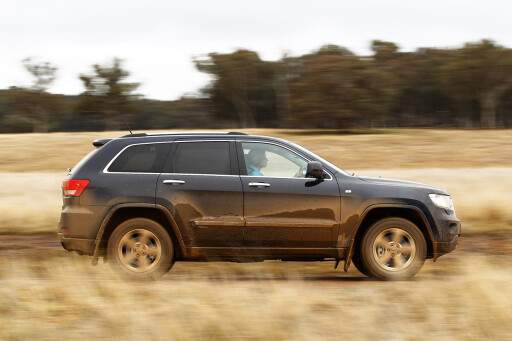 The low seating position in the dark cockpit-like cabin adds to the sporting feel, but the cabin and glasshouse design also limit visibility, making off-road driving more difficult.
The low seating position in the dark cockpit-like cabin adds to the sporting feel, but the cabin and glasshouse design also limit visibility, making off-road driving more difficult.
In contrast, the LandCruiser and Discovery ride high and tall, feeling more like traditional 4X4 wagons than the low-slung Grand Cherokee; if the Jeep feels like a sports sedan, the Cruiser is an unstoppable truck while the Discovery is akin to an all-road royal carriage.
The LC200 is the most traditional vehicle here in terms of construction. It retains a separate ladder chassis and has a live rear axle while the other two use full independent air suspension. The Cruiser has independent front suspension with coil springs and gas dampers; the rear axle is also suspended under coils and gas shocks with a sway bar.
The live axle under the back of the Toyota gives it plenty of wheel travel at that end. It is assisted by the KDSS set-up, which softens the front and rear sway bars under certain off-road situations to allow more wheel articulation. It works well off-road and maintains body control on the road.
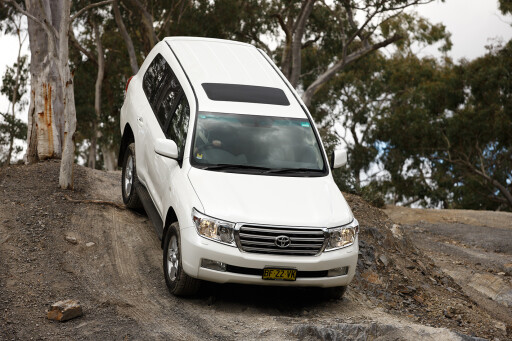 There’s nothing sporting about the way the Cruiser steers. Its massive body pitches and lurches under spirited driving, reminding the driver of the vehicle’s 2610kg mass (the heaviest of our trio). It’s a grand tourer rather than a sports tourer, but, when driven to its strengths, it’s hard to fault.
There’s nothing sporting about the way the Cruiser steers. Its massive body pitches and lurches under spirited driving, reminding the driver of the vehicle’s 2610kg mass (the heaviest of our trio). It’s a grand tourer rather than a sports tourer, but, when driven to its strengths, it’s hard to fault.
The supple suspension gives a soft, comfortable ride to deliver driver and passengers feeling relaxed after long hours on the road.
Helping to keep the Cruiser’s occupants smiling are big comfy leather pews with power adjustment on the front pair, quad-zone climate control, rear seat video entertainment with a single screen folding down from the roof, nine-speaker audio with Bluetooth phone connection, audio streaming and remote control, satnav, a proper fridge in the centre console, keyless entry and starting, and a power sunroof.
Keeping them safe are nine airbags, including side bags for all three rows of seats, electronic traction and stability control, and ABS brakes.
 Like the Off-Road Adventure Group-equipped Grand Cherokee, the Toyota rides on 18-inch alloy wheels, though with bigger 285/60R tyres. The spare is a matching alloy with a full-size tyre slung under the back, as is the Discovery’s; the Jeep’s is a 245/65R18 spare on a steel rim under the cargo floor.
Like the Off-Road Adventure Group-equipped Grand Cherokee, the Toyota rides on 18-inch alloy wheels, though with bigger 285/60R tyres. The spare is a matching alloy with a full-size tyre slung under the back, as is the Discovery’s; the Jeep’s is a 245/65R18 spare on a steel rim under the cargo floor.
Like its basic chassis design, the Cruiser’s 4X4 system is traditional and simple – full-time four-wheel-drive with a limited-slip centre diff, lockable via a dash button with low-range activated by a dial. With no clever electronic diffs or lockers, the Cruiser relies on its electronic traction control and abundant wheel travel to keep the tyres gripping and the vehicle moving forward. It’s simple and it works.
The LC200’s HDC is unique in that it is incorporated into what the company calls Crawl Control. Where HDC normally maintains vehicle speed to a set limit without driver intervention when going downhill only, Toyota’s Crawl Control works up and downhill, and on the flat.
It has three low-speed settings and is like cruise control for off-road use. Its usefulness is negligible. The Cruiser’s throttle pedal allows easy power control for climbing and the massive brakes and low-range gearing do a great job controlling descent speed.
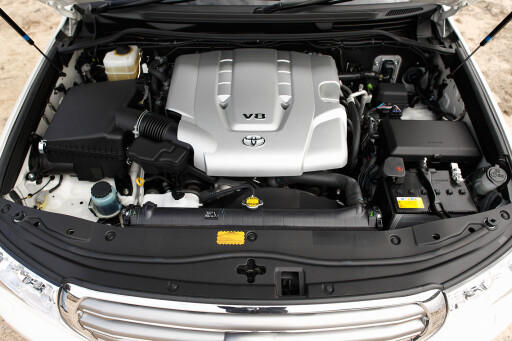 Using Crawl Control to maintain descent speed results in a noisy, jerky downhill ride that can be unnerving. It seems only Jeep has mastered HDC calibration for smooth operation. Land Rover’s Discovery 4 is a techno tour de force and loaded with gadgets.
Using Crawl Control to maintain descent speed results in a noisy, jerky downhill ride that can be unnerving. It seems only Jeep has mastered HDC calibration for smooth operation. Land Rover’s Discovery 4 is a techno tour de force and loaded with gadgets.
Its HDC isn’t as refined as the Jeep’s, while the calibration of the Terrain Response settings feels broader than in Jeep’s Selec-Terrain. We tend to go straight for the most aggressive Rock setting for heavy-duty off-road use, while the Sand setting is great for beach and desert driving.
For everything else, you can generally get away with the Normal setting. Four-wheel drive is full-time in the D4 and the centre differential is an auto-proportioning, auto-locking clutch type.
The aggressiveness of its actuation depends on the Terrain Response setting chosen, which is also the case for the auto-locking rear diff, standard on the V8, yet something you don’t even get on a $200,000 Range Rover Vogue. Low-range is selected via a console rocker switch.
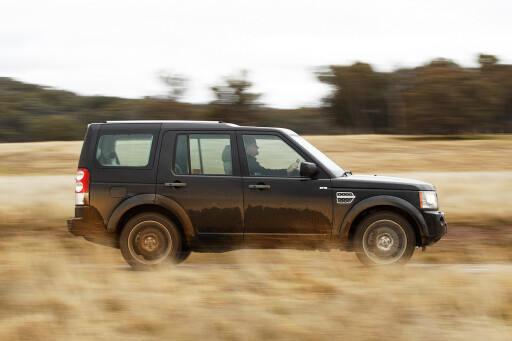 Something else to think about before taking the D4 into the rough stuff is the suspension height. Crank it up to the highest setting using a switch on the console and you shouldn’t have any problems.
Something else to think about before taking the D4 into the rough stuff is the suspension height. Crank it up to the highest setting using a switch on the console and you shouldn’t have any problems.
Like the Grand Cherokee, the D4 has an independent, height-adjustable air strut at each wheel, but, unlike the Jeep, the wheels are attached to the chassis on longer control arms that allow plenty of travel. There isn’t an independent suspension set-up that offers as much articulation as the Land Rover’s, and it matches many of the few remaining live-axle set-ups.
It’s what you’d expect of a specialist 4X4 vehicle manufacturer, and something Jeep could learn from. With its tyres staying in touch with the ground, its auto-locking e-diffs and quick-reacting electronic traction control, the D4 doesn’t suffer from the Jeep’s scrabbling for grip, and the full independent suspension configuration delivers a smoother, better-controlled ride on dirt roads than the Cruiser’s live rear axle.
It is the best suspension package in this trio, bettered only among current 4X4s by its Range Rover Vogue sibling. The D4’s suspension is equally impressive on the road where it works wonders to control the hefty 2550kg mass. It holds the middle ground between the sharp-steering Jeep (I never thought I would type those three words together in a sentence!) and the barge-like Toyota.
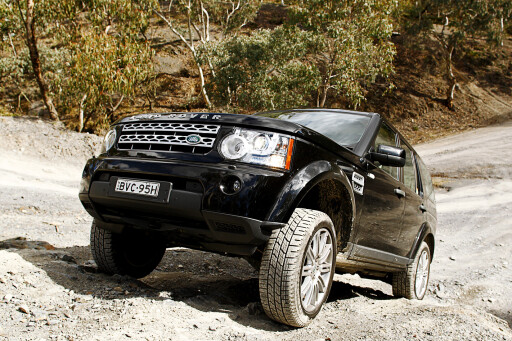 The D4 is no sports car, but it doesn’t steer and stop too badly considering its height and weight. Again, drive it within its limits and you will be rewarded. Aiding the Discovery’s dynamics are its low-profile tyres. They measure 255/50R20 and 20-inch alloys are standard on the D4 V8.
The D4 is no sports car, but it doesn’t steer and stop too badly considering its height and weight. Again, drive it within its limits and you will be rewarded. Aiding the Discovery’s dynamics are its low-profile tyres. They measure 255/50R20 and 20-inch alloys are standard on the D4 V8.
They are great on the sealed stuff, but very limited off it and there’s not much option for off-road rubber as 19-inch wheels are the smallest to fit over the Land Rover’s big brakes. Goodyear’s sometimes hard-to-find 19-inch MT/Rs are the only heavy-duty choice for them.
With its big, airy, leather-filled cabin, D4 feels the most luxurious in the group.
It has features to match, with three-zone climate control, three sunroofs (only the front one opens), rear-seat entertainment unit with six-DVD changer and screens in the front-seat headrests, premium leather trim, powered adjustment for the front seats, a heated windscreen and steering wheel, keyless entry and starting, a premium Harmon Kardon sound system with 14 speakers, Bluetooth phone integration, hard-disc storage, premium satnav with off-road functionality – and a quality feel.
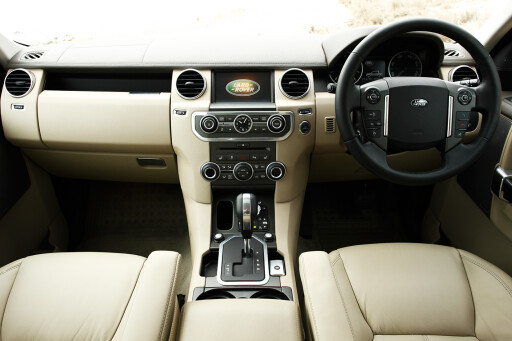 The Disco’s five-inch touch screen not only displays the satnav, audio system, off-road settings and image from the rear-view camera; there are plenty of cameras around the vehicle to aid driving in tight off-road situations. The rear-view camera is configured to aid hitching a trailer and cameras mounted in each side mirror show the sides of the vehicle.
The Disco’s five-inch touch screen not only displays the satnav, audio system, off-road settings and image from the rear-view camera; there are plenty of cameras around the vehicle to aid driving in tight off-road situations. The rear-view camera is configured to aid hitching a trailer and cameras mounted in each side mirror show the sides of the vehicle.
There is a pair of forward-facing cameras in the radiator grille. The V8 engine has been around for many decades, progressively refined for improved performance and efficiency. The Toyota and Land Rover engines both use four valves per cylinder and double overhead cams per bank with variable cam timing to give a broader spread of power and torque.
Toyota’s 2UZ-FE 4.7-litre engine has variable timing on the inlet cam only, while Land Rover’s Jaguar-sourced 5.0-litre, direct-injection V8 has variable timing on both the inlet and exhaust sides. It also boasts cam-profile switching, which shapes the profile and lift on the inlet cam lobes to give plenty of low-end grunt, changing them to a more economical profile for higher engine speeds.
The Jeep’s 5.7-litre Hemi V8 uses a more traditional cam-in-block, two-valve-per-cylinder configuration. It’s the only one in this group that uses a cylinder deactivation system, which shuts cylinders down under light-throttle running to save fuel. The Hemi engine feels the laziest of the trio even though it sports the largest capacity and is hauling the lightest vehicle at 2424kg.
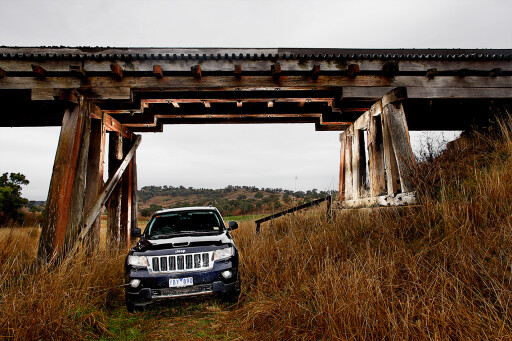 It lacks the bottom-end urge of the more high-tech engines, which give the driver more of a kick in the pants when mashing the go pedal. It would be hard to split the Cruiser and Disco for performance without lining them up on a racetrack, but the LR V8 feels more tractable with more oomph through its entire rev range, making it more rewarding to drive.
It lacks the bottom-end urge of the more high-tech engines, which give the driver more of a kick in the pants when mashing the go pedal. It would be hard to split the Cruiser and Disco for performance without lining them up on a racetrack, but the LR V8 feels more tractable with more oomph through its entire rev range, making it more rewarding to drive.
Jeep’s V8 consumed the least 95RON unleaded over the course of the test, averaging 17.4L/100km. The Discovery again held the middle ground with a 17.8L/100km average and the Cruiser maxxed out, averaging 18.5L/100km.
We doubt the Hemi’s clever cylinder deactivation had anything to do with its consumption, as we didn’t do too much light-throttle driving, but the Grand Cherokee is the lightest vehicle in the group, the lowest-riding and most streamlined. The Disco and Cruiser are very upright and push a lot of air, which uses a lot of fuel.
While we filled all the vehicles with 95RON PULP, only the Disco stipulates its use. With regular stops at the petrol pump required for all three wagons, the LC200’s 138-litre fuel capacity means you’ll be gassing up less often despite its thirstier nature. By comparison, the GC holds 93 litres and the D4 86.
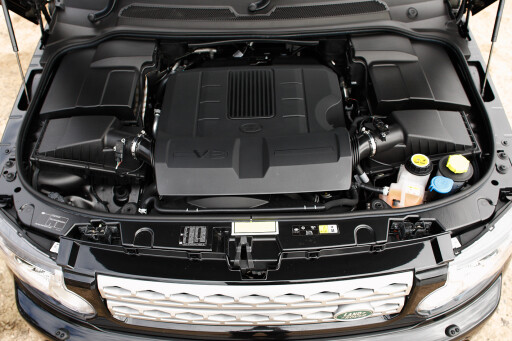 V8s can make great tow vehicles but, again, you’ll pay dearly at the pump when hauling a load. They are all rated to 3500kg. The D4’s payload is 692kg, the Cruiser’s is 690kg while the Jeep is somewhere between 525 and 642 depending on the level of optional equipment chosen.
V8s can make great tow vehicles but, again, you’ll pay dearly at the pump when hauling a load. They are all rated to 3500kg. The D4’s payload is 692kg, the Cruiser’s is 690kg while the Jeep is somewhere between 525 and 642 depending on the level of optional equipment chosen.
Choosing a winner here isn’t easy. If it were down to value for money alone, the Grand Cherokee would be a clear champion. It’s down close to half the price of the bigger vehicles, yet the Hemi Limited doesn’t lack on any of the features you want. It’s dynamically superior to the bigger wagons, giving it the feel of a poor man’s BMW X5, and that’s not a bad thing.
It is let down by its off-road performance, which we don’t expect of a Jeep and this disappoints as earlier Grand Cherokees have been so good in this regard, even if they would be no match for the WK on the road.
Despite its title, the Grand Cherokee doesn’t deliver the grandeur to match the Cruiser or the Discovery, yet it has enough to make it a worthy contender to the luxo-V8 crown. The Toyota and Land Rover V8s come in to play if you have more than $100,000 to blow – and that’s a big jump over the Grand Cherokee’s price.
 Seating capacity, off-road ability and the range of aftermarket accessories available favour the more expensive wagons, but there’s still that big price difference, which is enough to kit up your Grand Cherokee and put a camper trailer behind it ready for adventure.
Seating capacity, off-road ability and the range of aftermarket accessories available favour the more expensive wagons, but there’s still that big price difference, which is enough to kit up your Grand Cherokee and put a camper trailer behind it ready for adventure.
But then you’d more likely be looking to the more sensible diesel engine options. Buyers of petrol V8 4X4 wagons will be looking for excess in their vehicle of choice, and the Cruiser and D4 deliver in spades – the D4 just that little bit more so.
It has the muscle and the majesty to outclass the LandCruiser for opulence and performance, in town and on the tracks. Again there’s the price of a complete fit-out or camper trailer between the two, so if you were preparing for a lap of the country, the Cruiser could be for you. Either way, you’ll be doing it in style.



COMMENTS